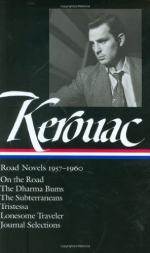|
|
On the Road Topic Tracking: Beat Generation
Beat Generation 1: Throughout this novel, Kerouac defines the 'beat generation' in terms of its activities and value system. So far, his generation relates to bars and jazz clubs as well as drugs like 'benny' or Benzedrine.
Beat Generation 2: Inside this prose, Kerouac further develops integral parts of the beat ideology and pop culture. In the description of Mississippi Gene, he complements him by comparing him to the 'old negro'. In opposition to mainstream U.S. culture, the Beats, especially Kerouac, idolized the black subculture for its lifestyle and music. He refers to the boxer Jack Dempsey as another touchstone for his generation.
Beat Generation 3: The idea of the Beat intellectual, a writer who experiments with drugs and mind-opening experiences, is contained here. In the characters of Carlo Marx and Dean, and their drug conversations, are reflections of the Beat generation's divergence with mainstream culture.
Beat Generation 4: Once again, the beat characters mix mystic intellectualism with drugs. The narrator, however, is not only a non-participant in the Benzedrine, but he is also pessimistic of the goal of finding one's soul.
Beat Generation 5: Remi and Sal are both willing to steal from their employees and light-heartedly use government dogma to justify it. The beat morality is not so corrupt that it justifies stealing as a general rule, but it justifies stealing between unequals.
Beat Generation 6: Sal returns to depression era wages to support his love, and abandons his crazy life on the road. Although many members of the Beat generation were fanatic and energetic, at some point, most of them had to settle down. This is not Sal's time, however.
Beat Generation 7: Sal describes in detail jazz and its combination with a fanatic Dean Moriarty. Jazz was a fundamental part of the Beat subculture. Jazz musicians were heroes and sages to them.
Beat Generation 8: In New Orleans, they continue their immersion in drugs and music. At this point, they are at the very height of the Beat ideal, crossing the country and stopping to meet fascinating people with whom they may do drugs.
Beat Generation 9: this quote reflects some of Kerouac's philosophy and the eastern influenced mysticism of the Beat generation. Buddhism became the gad religion of this group.
Bat Generation 10: Even though there is strife amidst the group of friends focused on Dean, they all go out to the jazz clubs. These clubs are an integral part of their social life. These clubs are the central part of their leisure time.
Beat Generation 11: One of their musician idols counters the running theme of sexual promiscuity. This is the first instance of a disjunctive relationship between Beat philosophy. The promiscuous sex doesn't quite work. Galatea plans to bring Ed to the Jazz clubs to get the craziness out of him. In their philosophy there is a measured acceptance of excessive behavior. Dean, however, is the epitome of this ideal gone bad.
Beat Generation 12: Kerouac once again characterizes his vision of this generation in their mad dash from bar to bar and jazz club to jazz club. This generation is made up of children of the night, eagerly pursuing the next hot spot.
Beat Generation 13: Kerouac's group and pictorial of his generation is inundated with popular culture. His description of Stan Shepherd is part of this. He describes the man in terms of an actor.
Beat Generation 14: The narrator reflects one of the popular ideas about marijuana and intoxication in general: that it allows people to get closer by helping them drop facades and social conventions.




